Global Hyperlocal Services Market Forecast
- The approximately US$1.8 Tn market for hyperlocal services to reach US$4.9 Tn in 2030
- Global hyperlocal services market value to rise high at a CAGR of 14.8% between 2023 - 2030
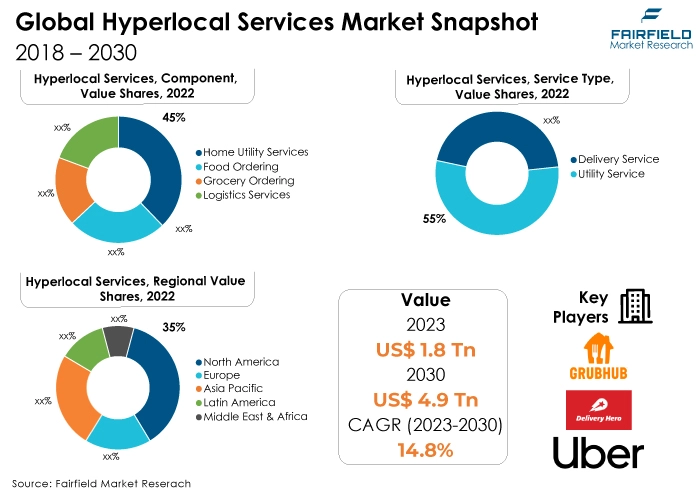
Quick Report Digest
- The key trend anticipated to fuel the hyperlocal services market growth is numerous e-commerce giants are embracing and acquiring hyperlocal companies to reduce transportation expenses and expedite delivery times. Furthermore, the demand for hyperlocal services has mostly increased due to the proliferation of smartphones and easy internet connectivity.
- Another major market trend expected to fuel the hyperlocal service market growth is a busy lifestyle, and a rise in working women contributes to the growth of the hyperlocal services market by driving the expansion of the online food and grocery ordering sector.
- In 2023, the home utility services category dominated the industry. Customer convenience, cost-effectiveness, and on-time delivery of goods have all contributed to increased demand for home utility services.
- In terms of market share for hyperlocal services globally, the utility service segment is anticipated to dominate. Growing urbanisation, a busy lifestyle, and an expanding working-age population create a high demand for home utility services. In contrast, an increasing working-age female population has fueled the expansion of hyperlocal utility services.
- The North American region is anticipated to account for the largest share of the global hyperlocal services market. The growing use of modern technology in daily life is a major driving force in North America, and it is predicted to boost the overall market expansion of the online hyper-local services market over the forecast period.
- The market for hyperlocal services is expanding in Asia Pacific due to the fast-increasing smartphone user base and the growing trend of digitisation in nations such as China and India, which can be credited to the region's rise.
A Look Back and a Look Forward - Comparative Analysis
The market for hyperlocal services has grown in popularity due to expanding internet accessibility and the number of smartphone users, the two main factors propelling the hyperlocal service market. The market is also driven by shifting consumer preferences and a readiness to embrace new technology.
The market witnessed staggered growth during the historical period 2018 - 2023. This is due to digital infrastructure deficiency, along with digital illiteracy, which is the cause of the lack of trust in online shopping. Consumers sometimes doubt online delivery products as they cannot test the quality in real life.
The primary factor driving the demand for hyperlocal services has been the proliferation of smartphones and easy internet connectivity. A busy lifestyle and a rise in working women contribute to the growth of the hyperlocal services market by driving the expansion of the online food and grocery ordering sector. E-commerce and mobile commerce platforms progressively embrace and acquire hyperlocal services to reduce delivery costs and times. Hyperlocal services are in high demand due to the growth of the e-commerce industry.
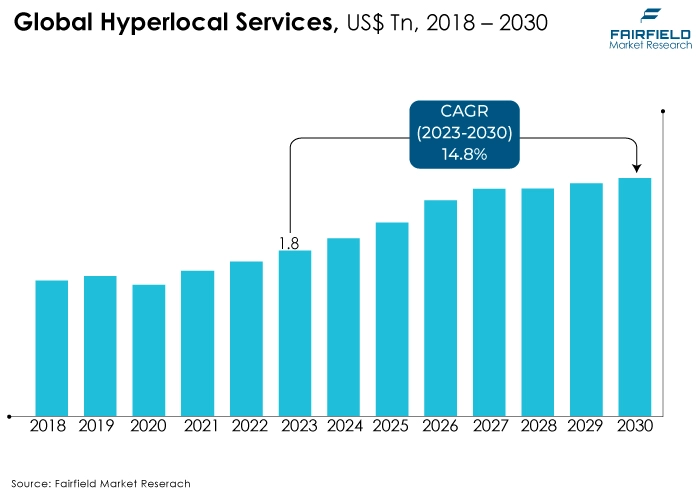
Key Growth Determinants
- Shifting Dietary and Lifestyle Patterns
Due to changes in consumer eating habits and busy lifestyles, there is an increased demand for various hyperlocal services, including meal delivery, shopping order fulfillment, home utility services, furniture delivery, and medicine delivery.
Rapid changes in enabling factors, including disposable income, customer preferences, the number of working women, and digitisation, have increased demand for hyperlocal services. Additionally, a rise in the demand for consumer products fuels the expansion of the hyperlocal service industry by increasing the number of supermarkets, hypermarkets, and retail stores.
- Increase in Net Spending
Improving economic conditions is a major factor propelling the hyperlocal service market's growth. An improvement in lifestyle brought about by a rise in per capita disposable income also gives consumers more purchasing power, which drives the hyperlocal services sector's growth.
Additionally, in recent years, growing Asian nations like China, and India have seen notable increases in disposable income. This has led to a rise in the cost of online shopping, which propels the expansion of the worldwide industry.
- Shorter Turnaround Times for Goods and Services
The epidemic has increased consumer demand for excellent services, especially lightning-fast and seamless delivery. This has spurred technical innovation, especially in the automotive and logistics industries. Automation, data collection, augmented reality, visibility, and Artificial Intelligence (AI) advancements have become indispensable due to shifting demands from suppliers and customers.
Everyone is trying to cut costs while speeding up processes and delivery frequency. Companies have become more accountable, responsive, and agile because of the increased pace and expansion in their quest to stay relevant and dominate the market.
Major Growth Barriers
- Inadequate Digital Infrastructure, and Digital Illiteracy
High levels of digital illiteracy are expected to impede the hyperlocal service market's expansion during the forecast period. This can be explained by the fact that low levels of digital literacy limit internet access and discourage smartphone purchases, which are bad for growing the hyperlocal services market.
The absence of digital infrastructure facilities for internet access is another significant barrier to the market for hyperlocal services. The majority of consumers of hyperlocal services access the internet through smartphone applications. Furthermore, an increase in digital illiteracy is brought on by limited access to computers and the Internet, especially in schools and universities, which limits the market's ability to grow.
- Extending Product Options to Isolated and Rural Areas
One main obstacle impeding market expansion is providing clients with the finest product quality while allowing access to marginal profits. Growing the customer base and commercial activity may potentially cause a product quality reduction, which could lead to a decrease in customer loyalty.
The sector is characterised by a vast array of local and international options, which increases customer volatility. Furthermore, these hyperlocal service markets can only serve customers in urban areas. These elements are anticipated to impede the players' continuous ability to build their businesses.
Key Trends and Opportunities to Look at
- Big Savings, and Affordable Product Offerings
The hyper-local services sector is defined by the large number of local businesses leaving their communities to pursue larger prospects for corporate expansion. Furthermore, some competitors have entered into substantial private companies that offer startup capital, so they may fortify their position by utilising marketing and promotional strategies to draw in a substantial clientele.
There is thus more competition among domestic and foreign players, which drives frequent large discounts and aggressive pricing strategies to keep customers. The market for hyperlocal services is expected to grow rapidly because of the substantial cost savings, and increased customer convenience brought about by easy access to resources.
- Rising Smartphone Adoption, and Increased Internet Users
The main factor driving the hyperlocal service market's expansion is the rise in smartphone adoption. This is related to the increased reliance on smartphones for everyday tasks and necessities like paying bills, transferring money, and buying tickets for movies and buses, among other services.
Due to the growing number of netizens worldwide, there is a significant increase in demand for various hyperlocal services, such as food ordering, grocery ordering, drug delivery, and home services. As a result, new entrants planning to operate in the hyperlocal market are expected to have lucrative opportunities.
- Partnership with Small Businesses in the Community
Hyperlocal service platforms are critical in linking local businesses with clients in their immediate region. By partnering with these platforms, local companies gain access to a larger audience, increased visibility, and streamlined operations. Platforms profit from the varied services provided by local businesses, which helps them recruit and retain a larger consumer base.
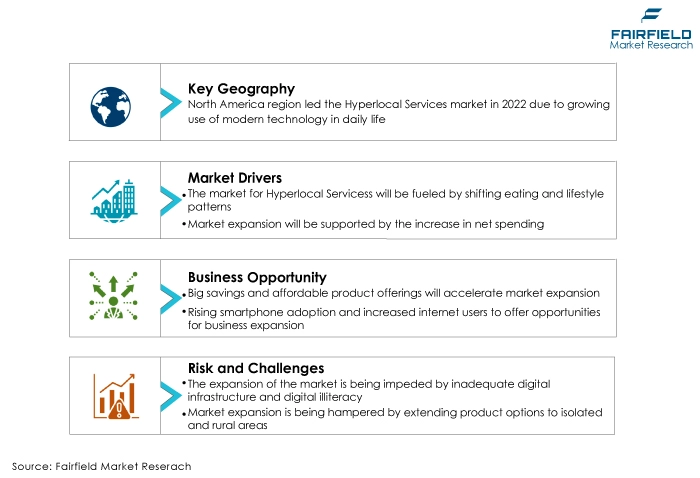
How Does the Regulatory Scenario Shape this Industry?
The regulatory environment for the hyperlocal service industry is complicated and constantly changing. Data privacy is one of the most important topics of legislation. Hyperlocal service platforms acquire a lot of information about their customers. Regulators are concerned about how this information is acquired, used, and preserved.
Some gig workers in the hyperlocal service economy may not be classified as employees, which can cause issues with labour laws and worker protection and competition. Regulators are concerned about the possibility of anti-competitive practices in the hyperlocal service market, such as price fixing or exclusive agreements.
The Federal Trade Commission (FTC) in the United States has published recommendations on data privacy and competition in the gig economy. Furthermore, the General Data Protection Regulation (GDPR) establishes tight guidelines for how businesses can gather and handle personal data. Furthermore, China has implemented several regulations governing the internet ride-hailing industry.
Fairfield’s Ranking Board
Top Segments
- Home Utility Services Category Continues to Dominate
The home utility services segment dominated the market in 2023. Home utility services market growth is likely to be boosted by innovations in offering home services and user-friendly experiences. The increasing popularity of smartphones encourages companies to use digital media marketing to increase visibility and sales. To promote their business, vendors send clients push notifications and emails with information about new services and deals.
Attributing to social media, customers are becoming aware of new home utility services. Because of the rising e-commerce and m-commerce platforms, home utility services are gaining substantial popularity and developing faster. Furthermore, the growing number of women working in the population and changing lifestyle patterns are significant factors promoting the rise of home utility services.
Furthermore, the grocery ordering category is projected to experience the fastest market growth. This is due to an increase in working women who don't have time for household tasks and hence prefer ordering online to save time and effort.
- Utility Services Continue to Surge Ahead
In 2023, the utility service category dominated the industry. Transportation, lodging, and education are examples of utility services. For example, home services in high consumer demand are electrical, plumbing, mechanical repairs, house cleaning, landscaping, roofing, and fencing.
While there is a growing need for residential utility services due to urbanisation, hectic lifestyles, and an aging working population, there is also a growing need for hyperlocal utility services brought on by the growing number of working women.
The delivery service category is anticipated to grow substantially throughout the projected period. Various goods can be delivered, including groceries, furniture, food, and medications or prescriptions. The proliferation of smartphones and the accessibility of online services have propelled market expansion in the delivery segment. The market for hyperlocal services is anticipated to grow during the forecast period due to advancements and service delivery improvisation.
Regional Frontrunners
North America Remains the Largest Revenue Contributing Region in the Global Hyperlocal Services Market
the growing investments for startups are anticipated to dominate in the North American region. Growing funding for new ventures and quick acceptance of technology innovations are two key elements propelling the hyperlocal services market's expansion in North America. As people were told to stay home during the lockdown, the region saw a sharp increase in digital orders for restaurants and groceries, leading to a significant demand for hyperlocal services. Moreover, the hyperlocal services market has experienced growth due to increasing urbanisation, a high working-age population, and a shortage of domestic assistance over the projection period.
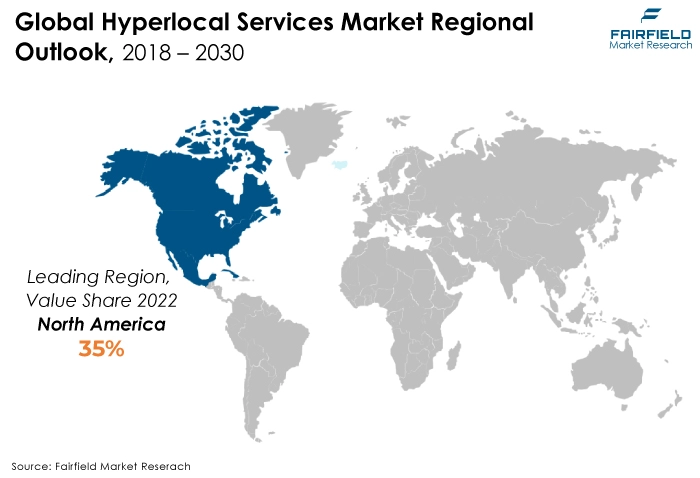
Asia Pacific Likely to Witness the Significant Growth in Sales During Forecast Period
Major developing countries with a strong consumer base dominate the region, driving expansion in the Asia Pacific hyperlocal services market. A working-age population and rising purchasing power draw global behemoths to this area for investment. Therefore, this aspect is helping the hyperlocal services industry in this region to grow. The working-age population, rising disposable income, and the widespread use of cell phones have all contributed to the hyperlocal service market's expansion. Because of the increased investment in startups and the government's strategic support for the national agenda, it is anticipated that it will continue growing during the projected period. For instance, to grow its business in 2019, UrbanClap, a platform for independent contractors in the UAE and India, raised an additional $75,000 in capital.
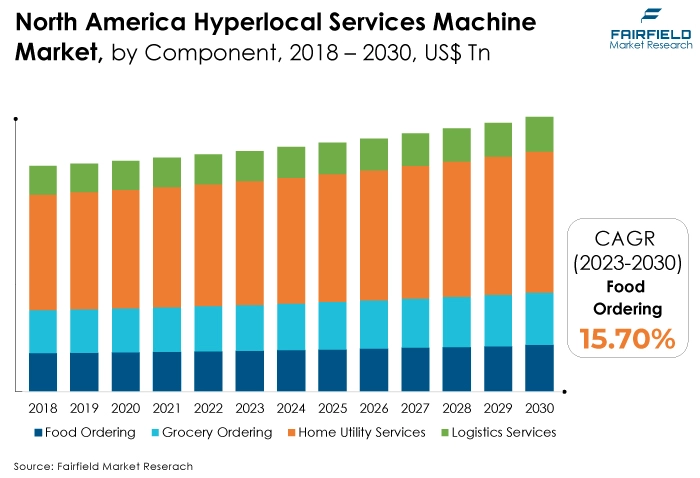
Fairfield’s Competitive Landscape Analysis
The global hyperlocal service market is a consolidated market with fewer major players present globally. The key players are introducing new products and working on the distribution channels to enhance their worldwide presence. Moreover, Fairfield Market Research expects more consolidation over the coming years.
Who are the Leaders in the Global Hyperlocal Services Space?
- Just East Takeaway N.V.
- Instacart
- AskforTask Inc
- Uber Technologies Inc
- Housekeep Limited
- TInyOwl Technology Pvt Ltd.
- GrubHub
- Delivery Hero
- Swiggy (Bundl Technologies Pvt. Ltd.)
- Zomato Ltd.
- Delivery Club
Significant Company Developments
New Product Launch
- February 2022: Grubhub Inc. announced the launch of Grubhub Goods worldwide. They provide more than 3,000 Grubhub Goods locations nationwide for on-demand convenience delivery to diners. This state-wide expansion was prompted by a successful pilot in New York when over a dozen Grubhub product locations were made available in conjunction with 7-Eleven in Manhattan.
- October 2020: Just Eat Takeaway Ltd. and Grubhub jointly announced that they have reached a legally binding agreement for Just Eat Takeaway Ltd. to purchase all of Grubhub's shares in an all-share deal.
- September 2021: Uber Technologies, Inc. announced the launch of their new "The Holiday Shop" series to help users find holiday essentials.
Distribution Agreement
- March 2021: To improve user experience, MapmyIndia was connected with EatFit, India's leading healthy food platform. EatFit is utilised with MapmyIndia's location technology, which provides the tracking routing algorithm and distance matrix APIs to enable EatFit kitchen discoverability to optimise the delivery network.
- December 2021: Delivery Hero SE ("Delivery Hero"), a global local delivery platform, stated that it has expanded its Logistics-as-a-Offering ("LaaS") service to over 25 markets globally. The company hopes to quickly deliver goods and services while leveraging its logistical capabilities and connecting the entire ecosystem.
An Expert’s Eye
Demand and Future Growth
As per Fairfield’s Analysis, the demand for hyperlocal services has mostly increased due to easy access to the internet and the proliferation of smartphones. Rising income levels and an increase in the working population drive growth in the online food and grocery delivery industry.
In reaction to the surge of COVID-19 instances, a few well-known businesses, like Zomato, McDonald's Corporation, and Domino's Pizza Inc., have also introduced contactless delivery services. As a result, it is projected that the market for hyperlocal services will see an increase in demand.
Supply Side of the Market
According to our analysis, the online hyper-local services market is anticipated to develop at an overall rate throughout the forecast period due to the growing usage of modern technology in daily life. This is the primary driving factor in the market. UberEats, the meal delivery service with the fastest growth rate in the US, has overtaken GrubHub as the top in the sector.
Throughout the forecast period, an increase in the number of start-up businesses in the US, and their funding partners is anticipated to propel the expansion of the hyperlocal service market. As per NASSCOM, in 2020, 203 unicorns were reported to have been counted in the US.
Global Hyperlocal Service Market is Segmented as Below:
By Component
- Food Ordering
- Grocery Ordering
- Home Utility Services
- Logistics Services
By Service Type:
- Delivery Service
- Utility Service
By Geographic Coverage:
- North America
- S.
- Canada
- Europe
- Germany
- K.
- France
- Italy
- Turkey
- Russia
- Rest of Europe
- Asia Pacific
- China
- Japan
- South Korea
- India
- Southeast Asia
- Rest of Asia Pacific
- Latin America
- Brazil
- Mexico
- Argentina
- Rest of Latin America
- Middle East & Africa
- GCC
- South Africa
- Egypt
- Nigeria
- Rest of Middle East & Africa
1. Executive Summary
1.1. Global Hyperlocal Services Market Snapshot
1.2. Future Projections
1.3. Key Market Trends
1.4. Regional Snapshot, by Value, 2022
1.5. Analyst Recommendations
2. Market Overview
2.1. Market Definitions and Segmentations
2.2. Market Dynamics
2.2.1. Drivers
2.2.2. Restraints
2.2.3. Market Opportunities
2.3. Value Chain Analysis
2.4. Porter’s Five Forces Analysis
2.5. Covid-19 Impact Analysis
2.5.1. Supply
2.5.2. Demand
2.6. Impact of Ukraine-Russia Conflict
2.7. Economic Overview
2.7.1. World Economic Projections
2.8. PESTLE Analysis
3. Global Hyperlocal Services Market Outlook, 2018 - 2030
3.1. Global Hyperlocal Services Market Outlook, by Component, Value (US$ Mn), 2018 - 2030
3.1.1. Key Highlights
3.1.1.1. Food Ordering
3.1.1.2. Grocery Ordering
3.1.1.3. Home Utility Services
3.1.1.4. Logistics Services
3.2. Global Hyperlocal Services Market Outlook, by Service Type, Value (US$ Mn), 2018 - 2030
3.2.1. Key Highlights
3.2.1.1. Delivery Service
3.2.1.2. Utility Service
3.3. Global Hyperlocal Services Market Outlook, by Region, Value (US$ Mn), 2018 - 2030
3.3.1. Key Highlights
3.3.1.1. North America
3.3.1.2. Europe
3.3.1.3. Asia Pacific
3.3.1.4. Latin America
3.3.1.5. Middle East & Africa
4. North America Hyperlocal Services Market Outlook, 2018 - 2030
4.1. North America Hyperlocal Services Market Outlook, by Component, Value (US$ Mn), 2018 - 2030
4.1.1. Key Highlights
4.1.1.1. Food Ordering
4.1.1.2. Grocery Ordering
4.1.1.3. Home Utility Services
4.1.1.4. Logistics Services
4.2. North America Hyperlocal Services Market Outlook, by Service Type, Value (US$ Mn), 2018 - 2030
4.2.1. Key Highlights
4.2.1.1. Delivery Service
4.2.1.2. Utility Service
4.2.2. BPS Analysis/Market Attractiveness Analysis
4.3. North America Hyperlocal Services Market Outlook, by Country, Value (US$ Mn), 2018 - 2030
4.3.1. Key Highlights
4.3.1.1. U.S. Hyperlocal Services Market by Component, Value (US$ Mn), 2018 - 2030
4.3.1.2. U.S. Hyperlocal Services Market Service Type, Value (US$ Mn), 2018 - 2030
4.3.1.3. Canada Hyperlocal Services Market by Component, Value (US$ Mn), 2018 - 2030
4.3.1.4. Canada Hyperlocal Services Market Service Type, Value (US$ Mn), 2018 - 2030
4.3.2. BPS Analysis/Market Attractiveness Analysis
5. Europe Hyperlocal Services Market Outlook, 2018 - 2030
5.1. Europe Hyperlocal Services Market Outlook, by Component, Value (US$ Mn), 2018 - 2030
5.1.1. Key Highlights
5.1.1.1. Food Ordering
5.1.1.2. Grocery Ordering
5.1.1.3. Home Utility Services
5.1.1.4. Logistics Services
5.2. Europe Hyperlocal Services Market Outlook, by Service Type, Value (US$ Mn), 2018 - 2030
5.2.1. Key Highlights
5.2.1.1. Delivery Service
5.2.1.2. Utility Service
5.2.2. BPS Analysis/Market Attractiveness Analysis
5.3. Europe Hyperlocal Services Market Outlook, by Country, Value (US$ Mn), 2018 - 2030
5.3.1. Key Highlights
5.3.1.1. Germany Hyperlocal Services Market by Component, Value (US$ Mn), 2018 - 2030
5.3.1.2. Germany Hyperlocal Services Market Service Type, Value (US$ Mn), 2018 - 2030
5.3.1.3. U.K. Hyperlocal Services Market by Component, Value (US$ Mn), 2018 - 2030
5.3.1.4. U.K. Hyperlocal Services Market Service Type, Value (US$ Mn), 2018 - 2030
5.3.1.5. France Hyperlocal Services Market by Component, Value (US$ Mn), 2018 - 2030
5.3.1.6. France Hyperlocal Services Market Service Type, Value (US$ Mn), 2018 - 2030
5.3.1.7. Italy Hyperlocal Services Market by Component, Value (US$ Mn), 2018 - 2030
5.3.1.8. Italy Hyperlocal Services Market Service Type, Value (US$ Mn), 2018 - 2030
5.3.1.9. Turkey Hyperlocal Services Market by Component, Value (US$ Mn), 2018 - 2030
5.3.1.10. Turkey Hyperlocal Services Market Service Type, Value (US$ Mn), 2018 - 2030
5.3.1.11. Russia Hyperlocal Services Market by Component, Value (US$ Mn), 2018 - 2030
5.3.1.12. Russia Hyperlocal Services Market Service Type, Value (US$ Mn), 2018 - 2030
5.3.1.13. Rest of Europe Hyperlocal Services Market by Component, Value (US$ Mn), 2018 - 2030
5.3.1.14. Rest of Europe Hyperlocal Services Market Service Type, Value (US$ Mn), 2018 - 2030
5.3.2. BPS Analysis/Market Attractiveness Analysis
6. Asia Pacific Hyperlocal Services Market Outlook, 2018 - 2030
6.1. Asia Pacific Hyperlocal Services Market Outlook, by Component, Value (US$ Mn), 2018 - 2030
6.1.1. Key Highlights
6.1.1.1. Food Ordering
6.1.1.2. Grocery Ordering
6.1.1.3. Home Utility Services
6.1.1.4. Logistics Services
6.2. Asia Pacific Hyperlocal Services Market Outlook, by Service Type, Value (US$ Mn), 2018 - 2030
6.2.1. Key Highlights
6.2.1.1. Delivery Service
6.2.1.2. Utility Service
6.2.2. BPS Analysis/Market Attractiveness Analysis
6.3. Asia Pacific Hyperlocal Services Market Outlook, by Country, Value (US$ Mn), 2018 - 2030
6.3.1. Key Highlights
6.3.1.1. China Hyperlocal Services Market by Component, Value (US$ Mn), 2018 - 2030
6.3.1.2. China Hyperlocal Services Market Service Type, Value (US$ Mn), 2018 - 2030
6.3.1.3. Japan Hyperlocal Services Market by Component, Value (US$ Mn), 2018 - 2030
6.3.1.4. Japan Hyperlocal Services Market Service Type, Value (US$ Mn), 2018 - 2030
6.3.1.5. South Korea Hyperlocal Services Market by Component, Value (US$ Mn), 2018 - 2030
6.3.1.6. South Korea Hyperlocal Services Market Service Type, Value (US$ Mn), 2018 - 2030
6.3.1.7. India Hyperlocal Services Market by Component, Value (US$ Mn), 2018 - 2030
6.3.1.8. India Hyperlocal Services Market Service Type, Value (US$ Mn), 2018 - 2030
6.3.1.9. Southeast Asia Hyperlocal Services Market by Component, Value (US$ Mn), 2018 - 2030
6.3.1.10. Southeast Asia Hyperlocal Services Market Service Type, Value (US$ Mn), 2018 - 2030
6.3.1.11. Rest of Asia Pacific Hyperlocal Services Market by Component, Value (US$ Mn), 2018 - 2030
6.3.1.12. Rest of Asia Pacific Hyperlocal Services Market Service Type, Value (US$ Mn), 2018 - 2030
6.3.2. BPS Analysis/Market Attractiveness Analysis
7. Latin America Hyperlocal Services Market Outlook, 2018 - 2030
7.1. Latin America Hyperlocal Services Market Outlook, by Component, Value (US$ Mn), 2018 - 2030
7.1.1. Key Highlights
7.1.1.1. Food Ordering
7.1.1.2. Grocery Ordering
7.1.1.3. Home Utility Services
7.1.1.4. Logistics Services
7.2. Latin America Hyperlocal Services Market Outlook, by Service Type, Value (US$ Mn), 2018 - 2030
7.2.1.1. Delivery Service
7.2.1.2. Utility Service
7.2.2. BPS Analysis/Market Attractiveness Analysis
7.3. Latin America Hyperlocal Services Market Outlook, by Country, Value (US$ Mn), 2018 - 2030
7.3.1. Key Highlights
7.3.1.1. Brazil Hyperlocal Services Market by Component, Value (US$ Mn), 2018 - 2030
7.3.1.2. Brazil Hyperlocal Services Market Service Type, Value (US$ Mn), 2018 - 2030
7.3.1.3. Mexico Hyperlocal Services Market by Component, Value (US$ Mn), 2018 - 2030
7.3.1.4. Mexico Hyperlocal Services Market Service Type, Value (US$ Mn), 2018 - 2030
7.3.1.5. Argentina Hyperlocal Services Market by Component, Value (US$ Mn), 2018 - 2030
7.3.1.6. Argentina Hyperlocal Services Market Service Type, Value (US$ Mn), 2018 - 2030
7.3.1.7. Rest of Latin America Hyperlocal Services Market by Component, Value (US$ Mn), 2018 - 2030
7.3.1.8. Rest of Latin America Hyperlocal Services Market Service Type, Value (US$ Mn), 2018 - 2030
7.3.2. BPS Analysis/Market Attractiveness Analysis
8. Middle East & Africa Hyperlocal Services Market Outlook, 2018 - 2030
8.1. Middle East & Africa Hyperlocal Services Market Outlook, by Component, Value (US$ Mn), 2018 - 2030
8.1.1. Key Highlights
8.1.1.1. Food Ordering
8.1.1.2. Grocery Ordering
8.1.1.3. Home Utility Services
8.1.1.4. Logistics Services
8.2. Middle East & Africa Hyperlocal Services Market Outlook, by Service Type, Value (US$ Mn), 2018 - 2030
8.2.1. Key Highlights
8.2.1.1. Delivery Service
8.2.1.2. Utility Service
8.2.2. BPS Analysis/Market Attractiveness Analysis
8.3. Middle East & Africa Hyperlocal Services Market Outlook, by Country, Value (US$ Mn), 2018 - 2030
8.3.1. Key Highlights
8.3.1.1. GCC Hyperlocal Services Market by Component, Value (US$ Mn), 2018 - 2030
8.3.1.2. GCC Hyperlocal Services Market Service Type, Value (US$ Mn), 2018 - 2030
8.3.1.3. South Africa Hyperlocal Services Market by Component, Value (US$ Mn), 2018 - 2030
8.3.1.4. South Africa Hyperlocal Services Market Service Type, Value (US$ Mn), 2018 - 2030
8.3.1.5. Egypt Hyperlocal Services Market by Component, Value (US$ Mn), 2018 - 2030
8.3.1.6. Egypt Hyperlocal Services Market Service Type, Value (US$ Mn), 2018 - 2030
8.3.1.7. Nigeria Hyperlocal Services Market by Component, Value (US$ Mn), 2018 - 2030
8.3.1.8. Nigeria Hyperlocal Services Market Service Type, Value (US$ Mn), 2018 - 2030
8.3.1.9. Rest of Middle East & Africa Hyperlocal Services Market by Component, Value (US$ Mn), 2018 - 2030
8.3.1.10. Rest of Middle East & Africa Hyperlocal Services Market Service Type, Value (US$ Mn), 2018 - 2030
8.3.2. BPS Analysis/Market Attractiveness Analysis
9. Competitive Landscape
9.1. Capacity vs Application Heatmap
9.2. Manufacturer vs Application Heatmap
9.3. Company Market Share Analysis, 2022
9.4. Competitive Dashboard
9.5. Company Profiles
9.5.1. Zomato Ltd.
9.5.1.1. Company Overview
9.5.1.2. Product Portfolio
9.5.1.3. Financial Overview
9.5.1.4. Business Strategies and Development
9.5.2. Swiggy (Bundl Technologies Pvt. Ltd.)
9.5.2.1. Company Overview
9.5.2.2. Product Portfolio
9.5.2.3. Financial Overview
9.5.2.4. Business Strategies and Development
9.5.3. Delivery Hero
9.5.3.1. Company Overview
9.5.3.2. Product Portfolio
9.5.3.3. Financial Overview
9.5.3.4. Business Strategies and Development
9.5.4. GrubHub
9.5.4.1. Company Overview
9.5.4.2. Product Portfolio
9.5.4.3. Financial Overview
9.5.4.4. Business Strategies and Development
9.5.5. TInyOwl Technology Pvt Ltd.
9.5.5.1. Company Overview
9.5.5.2. Product Portfolio
9.5.5.3. Financial Overview
9.5.5.4. Business Strategies and Development
9.5.6. Housekeep Limited
9.5.6.1. Company Overview
9.5.6.2. Product Portfolio
9.5.6.3. Financial Overview
9.5.6.4. Business Strategies and Development
9.5.7. Uber Technologies Inc
9.5.7.1. Company Overview
9.5.7.2. Product Portfolio
9.5.7.3. Financial Overview
9.5.7.4. Business Strategies and Development
9.5.8. AskforTask Inc
9.5.8.1. Company Overview
9.5.8.2. Product Portfolio
9.5.8.3. Business Strategies and Development
9.5.9. Instacart
9.5.9.1. Company Overview
9.5.9.2. Product Portfolio
9.5.9.3. Financial Overview
9.5.9.4. Business Strategies and Development
9.5.10. Just East Takeaway N.V.
9.5.10.1. Company Overview
9.5.10.2. Product Portfolio
9.5.10.3. Financial Overview
9.5.10.4. Business Strategies and Development
9.5.11. Delivery Club
9.5.11.1. Company Overview
9.5.11.2. Product Portfolio
9.5.11.3. Financial Overview
9.5.11.4. Business Strategies and Development
10. Appendix
10.1. Research Methodology
10.2. Report Assumptions
10.3. Acronyms and Abbreviations
|
BASE YEAR |
HISTORICAL DATA |
FORECAST PERIOD |
UNITS |
|||
|
2022 |
|
2018 - 2022 |
2023 - 2030 |
Value: US$ Million |
||
|
REPORT FEATURES |
DETAILS |
|
Component Coverage |
|
|
Service Type Coverage |
|
|
Geographical Coverage |
|
|
Leading Companies |
|
|
Report Highlights |
Key Market Indicators, Macro-micro economic impact analysis, Technological Roadmap, Key Trends, Driver, Restraints, and Future Opportunities & Revenue Pockets, Porter’s 5 Forces Analysis, Historical Trend (2019-2021), Market Estimates and Forecast, Market Dynamics, Industry Trends, Competition Landscape, Category, Region, Country-wise Trends & Analysis, COVID-19 Impact Analysis (Demand and Supply Chain) |
